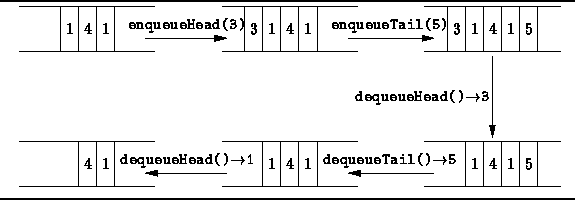In the preceding section we saw that a queue comprises a pile of objects
into which we insert items at one end
and from which we remove items at the other end.
In this section we examine an extension of the queue
which provides a means to insert and remove items at both ends of the pile.
This data structure is a deque .
The word deque is an acronym derived
from double-ended queue .![]()
Figure ![]() illustrates the basic deque operations.
A deque provides three operations which access the head of the queue,
getHead, enqueueHead and dequeueHead,
and three operations to access the tail of the queue,
getTail, enqueueTail and dequeueTail.
illustrates the basic deque operations.
A deque provides three operations which access the head of the queue,
getHead, enqueueHead and dequeueHead,
and three operations to access the tail of the queue,
getTail, enqueueTail and dequeueTail.

Figure: Basic deque operations.
Program ![]() defines the Deque interface.
The Deque interface extends the Container interface
defined in Program
defines the Deque interface.
The Deque interface extends the Container interface
defined in Program ![]() .
Hence, it comprises all of the methods inherited from Container
plus the six methods,
getHead, enqueueHead, dequeueHead,
getTail, enqueueTail, and dequeueTail.
.
Hence, it comprises all of the methods inherited from Container
plus the six methods,
getHead, enqueueHead, dequeueHead,
getTail, enqueueTail, and dequeueTail.